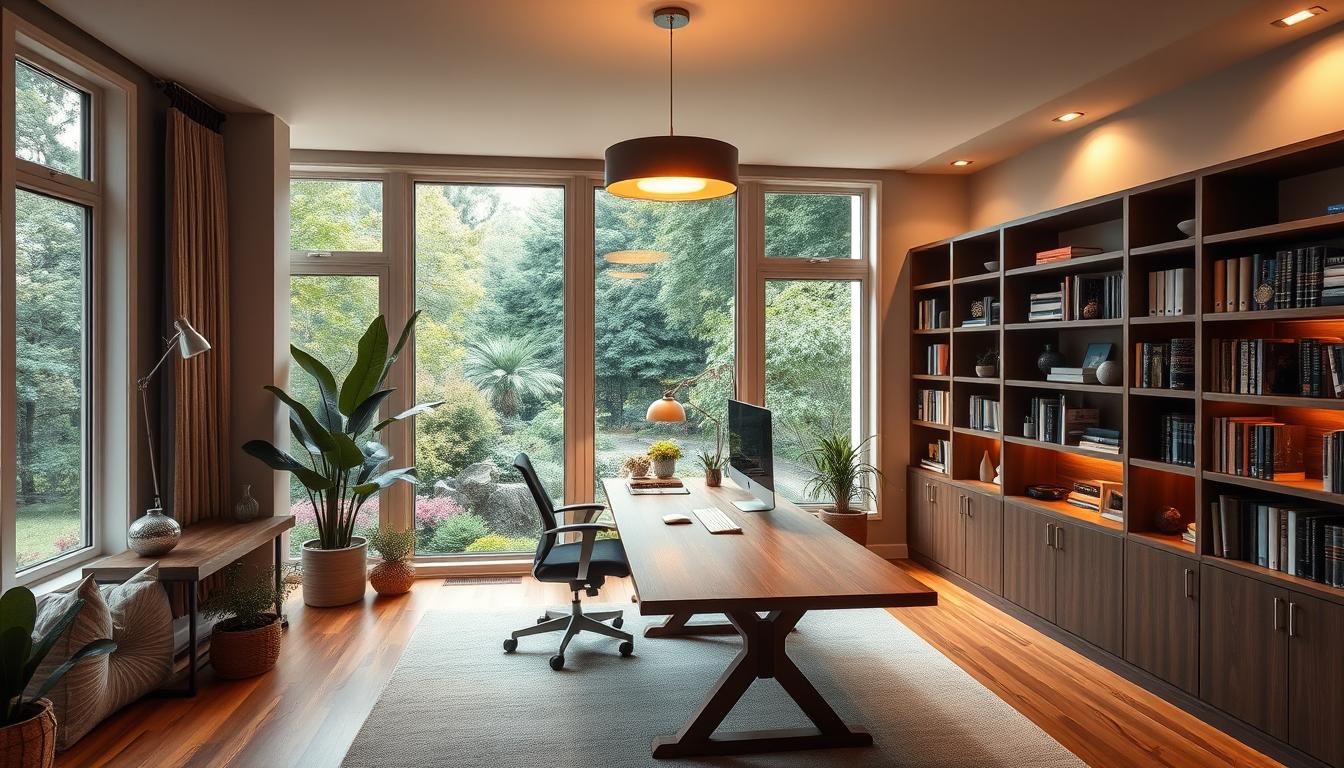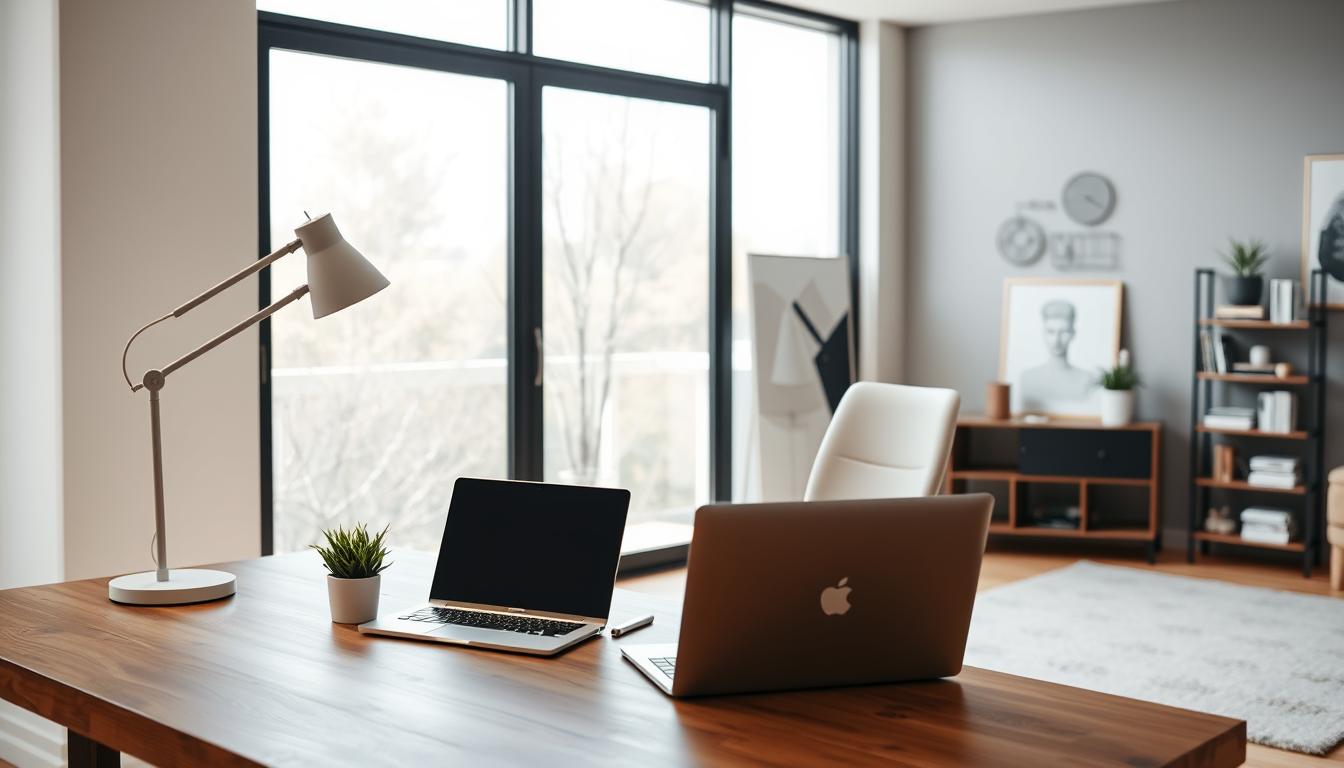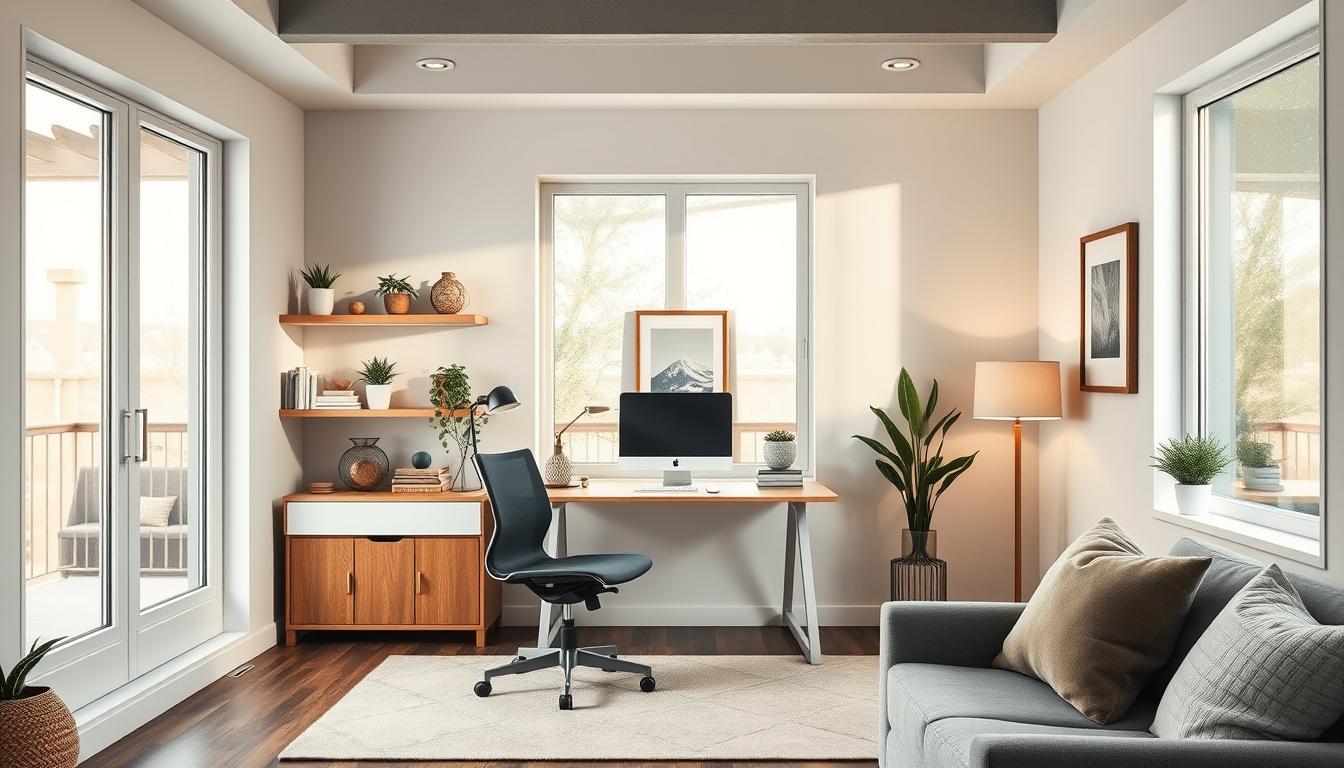More people work from home than ever before. Creating a good workspace at home is now a must. A well-designed home office can make you more productive and comfortable.
We’ll show you how to set up a workspace that helps you focus better. Our guide covers everything from layout to making your space future-proof. It’s all about making your workspace better for you.
Key Takeaways
- Create a dedicated workspace to boost productivity.
- Assess your available space to optimize your office layout.
- Consider ergonomic furniture for enhanced comfort.
- Incorporate good lighting to reduce eye strain.
- Future-proof your office with adaptable technology.
Assessing Your Space: Finding the Ideal Location
To create a productive home office, start by checking your space. Find the best spot for your work area. This is key for your productivity and comfort.
Consider Natural Light Sources
Natural light can make you feel better and work better. Look for spots in your home that get lots of sunlight. Your home office should be near a window for the best light.
Analyze Noise Levels
Noise can mess with your focus. Find quiet spots in your home, away from busy areas. Use noise-cancelling materials or apps if you can’t find a quiet spot.
Think About Accessibility
Getting to your home office should be easy. Make sure it’s in a spot that’s easy to get to. It should also have enough room for your stuff and furniture.
| Location | Natural Light | Noise Level | Accessibility |
|---|---|---|---|
| Living Room | Medium | High | High |
| Bedroom | Low | Low | Medium |
| Home Attic | Low | Low | Low |
| Near a Window | High | Medium | High |
Think about these things to make a home office that’s comfy and productive. This will make your work time better.
Choosing the Right Furniture for Comfort and Style
A well-designed home office starts with the right furniture. The furniture you choose can greatly impact your productivity. We will explore the essential elements of furniture for a comfortable and efficient workspace.
Desks: Types and Ergonomics
The desk is a central piece of furniture in any home office. There are various types of desks, including standing desks, corner desks, and traditional rectangular desks. When choosing a desk, consider the size of your workspace and the type of work you will be doing. Ergonomics play a crucial role in desk selection.
An ergonomic desk should allow you to work comfortably. It should have your monitor at eye level, keyboard and mouse within easy reach, and adequate space for your paperwork or other tasks.
Standing desks have gained popularity due to their health benefits. Corner desks are ideal for maximizing space in smaller rooms. Traditional desks offer versatility and can fit into most home office layouts.
Chairs: Importance of Comfort
A comfortable chair is vital for maintaining productivity during long working hours. An ergonomic chair provides the necessary support for your back. It promotes good posture and reduces the risk of developing back pain or other musculoskeletal disorders.
Look for a chair that is adjustable in height and lumbar support. Consider one with breathable fabric to keep you cool. When selecting a chair, test it out to ensure it meets your comfort needs.
Storage Solutions for an Organized Workspace
An organized workspace is key to maintaining efficiency and reducing stress. Storage solutions such as filing cabinets, shelves, and desk organizers can help keep your home office tidy. Consider the type of work you do and the items you need to store when selecting storage solutions.
For instance, if you deal with a lot of paperwork, a filing cabinet is essential. Shelves can be used to store books, decorative items, or office supplies. They keep them within reach but out of the way.
Color Psychology: Selecting the Perfect Palette
Color psychology is key in creating a home office that works well and looks good. The colors you pick can really affect your mood, how productive you are, and your work experience.
Calming Colors for Focus
For a home office that needs focus, use calming colors. These colors help you stay calm and focused. Blue and green are great for this because they reduce stress and boost focus.
- Light Blue: Encourages clarity and calmness.
- Pale Green: Enhances balance and growth.
Energizing Hues for Creativity
For creative work, use colors that energize and inspire. Orange and yellow are perfect because they increase creativity and energy.
- Orange: Stimulates creativity and enthusiasm.
- Yellow: Enhances happiness and optimism.
Accent Colors to Inspire
Accent colors can make your home office feel more personal and motivating. Use bold colors like red or purple as accents. They add depth and character to your space.
- Red: Adds energy and passion.
- Purple: Encourages luxury and creativity.
Think about your work and the mood you want in your office when picking colors. The right colors can boost your productivity, spark creativity, and turn your home office into a place where you love to work.
Lighting Essentials: Brightening Your Home Office
The right lighting can make your home office comfortable and efficient. It’s not just about seeing well; it also affects your mood and how productive you are. When setting up your small home office ideas, think about the lighting you need.
Natural vs. Artificial Lighting
Natural light is great for any workspace because it boosts your mood and energy. But, it can be hard to get enough natural light all the time. That’s where artificial lighting comes in, offering a steady and adjustable light source.
Artificial lighting can be set up for different tasks and areas in your home office. For example, LED bulbs give bright, energy-saving light that you can adjust as needed.
Task Lighting: Types and Placement
Task lighting focuses on specific areas where you do tasks, reducing eye strain and helping you focus. Common types include desk lamps, under-cabinet lighting, and floor lamps.
- Desk lamps are perfect for focused work, providing direct light exactly where it’s needed.
- Under-cabinet lighting is great for workspaces with cabinets or shelves, illuminating the area below.
- Floor lamps can provide ambient lighting and are versatile in their placement.
Dimmable Lighting Options
Dimmable lighting lets you change the light intensity as needed, creating a flexible lighting environment. This is very useful in a home office where lighting needs can change throughout the day.
| Lighting Type | Benefits | Best For |
|---|---|---|
| Natural Light | Boosts mood, energy-efficient | General workspace illumination |
| Task Lighting | Reduces eye strain, improves focus | Specific tasks, reading, computer work |
| Dimmable Lighting | Flexible, adjustable intensity | Changing lighting needs throughout the day |
As interior design experts suggest, mixing different lighting types can make a harmonious and functional workspace. By using natural light, task lighting, and dimmable options, you can create a lighting plan that boosts your productivity and comfort.
“Good lighting is crucial for creating a workspace that is both functional and comfortable. It’s not just about seeing; it’s about feeling.”
Essential Technology: Equipping Your Workspace
To make your workspace efficient, you need the right tech tools. A well-equipped home office boosts productivity and makes workflow smoother.
Computers and Accessories
The computer is key in any home office. Pick a computer based on your work needs. For office tasks, a laptop or desktop with enough RAM and storage works well.
Also, get a good keyboard, mouse, and monitor. These accessories can make your work better.
Key considerations for computers and accessories include:
- Processor speed and type
- Amount of RAM and storage capacity
- Display quality and size
- Ergonomic keyboard and mouse options
High-Speed Internet Needs
A fast, reliable internet is vital for a home office. It helps with communication, cloud computing, and quick access to online resources.
When selecting an internet plan, consider:
- Speed requirements based on your work needs
- Reliability and uptime guarantees
- Data caps and additional fees
Tools for Collaboration
In today’s remote work, collaboration tools are essential. They let teams work together, no matter where they are.
Popular collaboration tools include:
| Tool | Purpose | Key Features |
|---|---|---|
| Slack | Team communication | Channels, direct messaging, file sharing |
| Zoom | Video conferencing | High-definition video, screen sharing, recording capabilities |
| Trello | Project management | Boards, lists, cards, task assignments |
Personal Touch: Adding Decor and Style
Adding personal touches to your home office can really make it better. A good home office is not just useful; it shows who you are and your style.
Artwork and Wall Decor Ideas
Art and wall decor can make your home office unique. Think about using framed prints or paintings that show your taste. You can also use wall decals or stickers for color or texture.
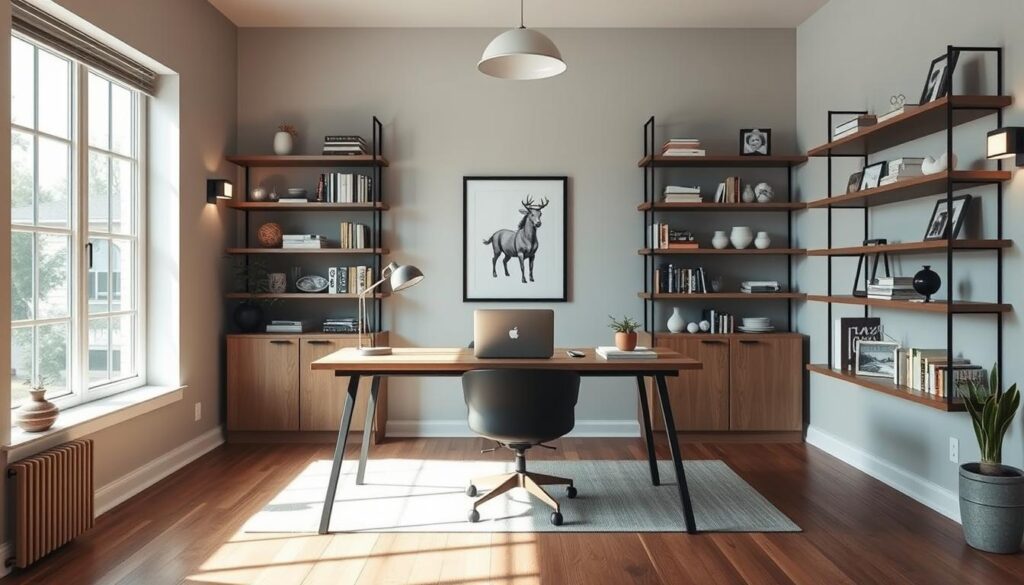
- Choose artwork that inspires you and sparks creativity.
- Use wall decor to add visual interest and create a focal point in the room.
- Consider a mix of frame styles and sizes to add depth and character.
Plants for a Breath of Fresh Air
Plants in your home office can clean the air and make you feel better. Good office plants are snake plants, spider plants, and peace lilies.
| Plant Type | Benefits | Care Level |
|---|---|---|
| Snake Plant | Air purification, low maintenance | Easy |
| Spider Plant | Air purification, easy to propagate | Moderate |
| Peace Lily | Air purification, elegant appearance | Moderate |
Incorporating Personal Mementos
Personal mementos can make your home office feel more like home. Display family photos, heirlooms, or collectibles that mean something to you.
By adding these personal touches, you make your home office both useful and a reflection of you. This can improve your creativity, productivity, and job happiness.
Setting Up Functional Zones in Your Office
A well-organized home office is more than furniture. It’s about setting up zones for different needs. This boosts productivity, cuts distractions, and makes your space comfy and efficient.
Creating a Work Zone
The work zone is your office’s core, where you do most tasks. Choose a comfortable and ergonomic desk and a supportive chair. Make sure it’s well-lit, with both natural and artificial light.
For small home office ideas, think about wall-mounted desks or compact furniture. They save space.
Designating a Relaxation Area
A relaxation area in your office helps you recharge and balance work and life. It could be a cozy reading nook or a comfy chair in a quiet spot. Adding plants, artwork, or a small fountain can make it more calming.
Space for Creative Projects
For creative projects, a dedicated space boosts innovation and productivity. It might have art supplies, craft materials, or musical instruments. Make sure it’s inspiring and easy to get to your tools.
Designing these zones thoughtfully makes your home office efficient and enjoyable.
Organizing Your Workflow with Smart Solutions
Streamlining your workflow can greatly increase your productivity. By using effective strategies, your home office can stay organized and efficient.
Effective File Management
Good file management is key to a well-organized workflow. This includes both physical and digital files. For physical files, use a labeled filing cabinet. For digital files, cloud storage like Google Drive or Dropbox is great. Always use a consistent naming system for your files.
- Create clear and descriptive file names
- Use folders and subfolders to categorize files
- Regularly clean out unnecessary files
Digital Organization Tools
Many digital tools can help you stay organized. Tools like Trello or Asana help manage tasks and deadlines. Note-taking apps like Evernote or OneNote are perfect for jotting down ideas. A password manager like LastPass keeps your passwords safe.
- Trello for project management
- Evernote for note-taking
- LastPass for password management
Time Management Strategies
Good time management is essential for productivity. Try the Pomodoro Technique, which involves focused 25-minute work sessions with 5-minute breaks. Time blocking helps schedule tasks in fixed slots. Use the Eisenhower Matrix to prioritize tasks based on urgency and importance.
By using these smart solutions, you can greatly improve your workflow and boost productivity.
Implementing Ergonomic Practices
Working from home more often means we need to think about ergonomics. A healthy workspace is key for staying productive and feeling good.
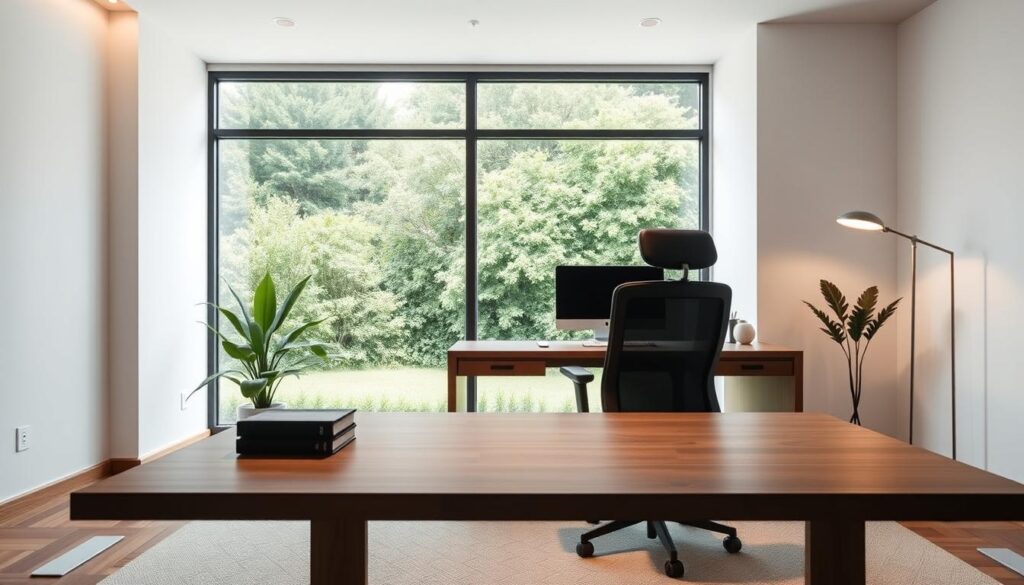
Importance of Ergonomic Furniture
Ergonomic furniture helps prevent injuries at work. Getting a good ergonomic chair is a must. It keeps your spine in its natural shape and eases back pain.
- Look for adjustable height and lumbar support in an ergonomic chair.
- A sit-stand desk is also great. It lets you switch between sitting and standing all day.
Correct Monitor and Keyboard Placement
Where you put your monitor and keyboard is important for your eyes and comfort. Place your monitor right in front of you, about 20-25 inches away. It should be at a height where you look slightly down.
- Make sure your keyboard is at a height that lets your elbows bend at 90 degrees.
- Keep your wrists straight. Don’t bend them up or down.
Stretching and Movement Breaks
Regular stretching and moving can prevent muscle problems. Take a break every 30-60 minutes to stretch or move.
- Try simple stretches like shoulder rolls, neck stretches, and wrist extensions.
- Standing up and walking around boosts blood flow and fights off tiredness.
Using these ergonomic tips can make your home office healthier and more comfy. It boosts your work and keeps you feeling great.
Ensuring Privacy and Focus in Your Workspace
Creating a productive home office is more than just a desk and chair. It needs a space that helps you focus and keeps distractions away. To do this, you must use strategies that boost privacy and help you concentrate.
Soundproofing Techniques
Soundproofing is a great way to keep your space private. It involves using materials and methods to lower noise levels. This keeps sound from getting in or out of your workspace. For a small home office, you can start with acoustic panels or thick rugs and heavy curtains.
Some effective soundproofing techniques include:
- Sealing gaps and cracks with acoustic sealant
- Installing mass-loaded vinyl on walls and ceilings
- Using soundproofing blankets or panels
Utilizing Screen Partitions
Screen partitions are also great for privacy. They work well in open-plan homes or shared workspaces. These partitions visually separate your area, cutting down on distractions and making you feel more secluded.
When picking a screen partition for your home office design, think about these points:
| Material | Benefits |
|---|---|
| Wood | Durable, aesthetically pleasing |
| Glass | Allows natural light, modern look |
| Fabric | Flexible, easy to move |
Creating a Distraction-Free Environment
To boost productivity, you need a distraction-free space. This means soundproofing, using screen partitions, and organizing your area to avoid clutter and visual distractions.
Here are some tips for a distraction-free space:
- Decluttering your workspace regularly
- Using storage solutions to keep essential items out of sight
- Implementing a “one touch” rule for handling paperwork
By using these strategies, you can make a home office that supports productivity and focus. Whether your space is small or large, keeping it private and free from distractions is key to reaching your work goals.
Maintaining Your Home Office: Tips for Consistency
A well-maintained home office is key to staying focused and efficient. To achieve this, it’s essential to establish routines and practices that keep your workspace organized and functional.
Regular Decluttering Routines
Regular decluttering is vital to maintaining a productive home office. Set aside time each week to tidy up your workspace. This includes sorting through papers, dusting surfaces, and organizing your belongings.
To make decluttering more manageable, consider implementing a categorization system for your documents and office supplies. Use labeled folders, bins, or drawers to keep items neatly stored and easily accessible.
Seasonal Updates to Decor
Updating your home office decor seasonally can help keep your workspace feeling fresh and inspiring. Consider changing your color scheme or adding seasonal decorations to reflect the current time of year. For example, you might add some bright flowers in the spring or cozy throw blankets in the winter.
Seasonal updates don’t have to be major; even small changes, like swapping out wall art or rearranging your furniture, can make a big difference in how your office feels.
Consistent Tech Maintenance
Regular tech maintenance is crucial for ensuring your home office remains functional and efficient. Regularly update your software and hardware to keep your systems running smoothly. This includes updating your operating system, antivirus software, and any other critical applications.
Also, make sure to back up your data regularly to prevent losses in case of a technical failure. Using cloud storage services or external hard drives can provide an extra layer of security for your important files.
By incorporating these maintenance tips into your routine, you can keep your home office organized, functional, and comfortable. This will enhance your productivity and work satisfaction.
Future-Proofing Your Home Office
As we move forward in the world of remote work, it’s key to make our home offices ready for the future. We need to get ready for new work styles, use the latest tech, and create a space that can change with us.
Adapting to Change
We must be ready to change our home office to meet new remote work needs. This means getting furniture that can change and using designs that can be rearranged easily.
Technological Integration
Keeping up with new tech is important. Adding smart tools and top-notch gear can make our home office better and more efficient.
Flexible Design
A design that can change with us is vital. By making a space that works well and can adapt, we keep our home office productive for years.
